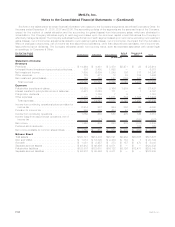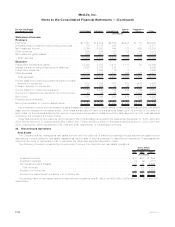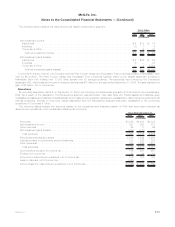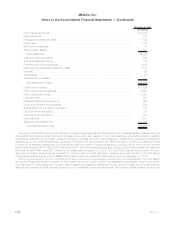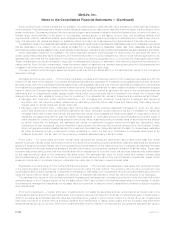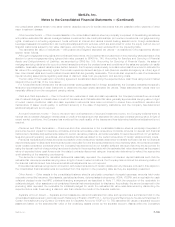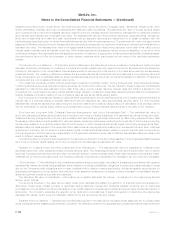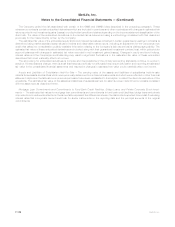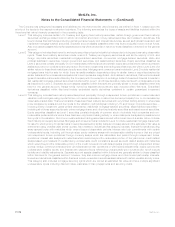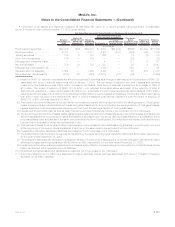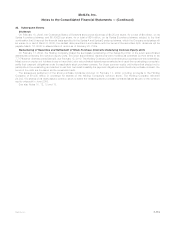MetLife 2008 Annual Report Download - page 227
Download and view the complete annual report
Please find page 227 of the 2008 MetLife annual report below. You can navigate through the pages in the report by either clicking on the pages listed below, or by using the keyword search tool below to find specific information within the annual report.When quoted prices in active markets are not available, the determination of estimated fair value is based on market standard valuation
methodologies. The market standard valuation methodologies utilized include: discounted cash flow methodologies, matrix pricing or other
similar techniques. The assumptions and inputs in applying these market standard valuation methodologies include, but are not limited to:
interest rates, credit standing of the issuer or counterparty, industry sector of the issuer, coupon rate, call provisions, sinking fund
requirements, maturity, estimated duration and management’s assumptions regarding liquidity and estimated future cash flows. Accord-
ingly, the estimated fair values are based on available market information and management’s judgments about financial instruments.
The significant inputs to the market standard valuation methodologies for certain types of securities with reasonable levels of price transparency are inputs
that are observable in the market or can be derived principally from or corroborated by observable market data. Such observable inputs include
benchmarking prices for similar assets in active, liquid markets, quoted prices in markets that are not active and observable yields and spreads in themarket.
When observable inputs are not available, the market standard valuation methodologies for determining the estimated fair value of
certain types of securities that trade infrequently, and therefore have little or no price transparency, rely on inputs that are significant to the
estimated fair value that are not observable in the market or cannot be derived principally from or corroborated by observable market data.
These unobservable inputs can be based in large part on management judgment or estimation, and cannot be supported by reference to
market activity. Even though unobservable, these inputs are based on assumptions deemed appropriate given the circumstances and
consistent with what other market participants would use when pricing such securities.
The use of different methodologies, assumptions and inputs may have a material effect on the estimated fair values of the Company’s
securities holdings.
Mortgage and Consumer Loans — The Company originates mortgage and consumer loans for both investment purposes and with the
intention to sell them to third parties. Commercial and agricultural loans are originated for investment purposes and are primarily carried at
amortized cost within the consolidated financial statements. Loans classified as consumer loans are generally purchased from third parties
for investment purposes and are primarily carried at amortized cost. Mortgage loans held-for-sale consist principally of residential mortgage
loans for which the Company has elected the fair value option and which are carried at estimated fair value in the consolidated financial
statements and to a significantly lesser degree certain loans which were previously held-for-investment but where the Company has
changed its intention as it relates to holding them for investment. The estimated fair values of these loans are determined as follows:
•Mortgage and Consumer Loans Held-for-Investment — For mortgage and consumer loans held-for-investment and carried at
amortized cost, fair value is primarily determined by estimating expected future cash flows and discounting them using current
interest rates for similar loans with similar credit risk.
•Mortgage Loans Held-for-Sale — Mortgage loans held-for-sale principally includes residential mortgages for which the fair value
option was elected and which are carried at estimated fair value. Generally, quoted market prices are not available for residential
mortgage loans held-for-sale; accordingly, the estimated fair values of such assets are determined based on observable pricing of
residential mortgage loans held-for-sale with similar characteristics, or observable pricing for securities backed by similar types of
loans, adjusted to convert the securities prices to loan prices. When observable pricing for similar loans or securities that are backed
by similar loans are not available, the estimated fair values of residential mortgage loans held-for-sale are determined using
independent broker quotations, which is intended to approximate the amounts that would be received from third parties. Certain
other mortgages previously classified as held-for-investment have also been designated as held-for-sale. For these loans, estimated
fair value is determined using independent broker quotations or, when the loan is in foreclosure or otherwise determined to be
collateral dependent, the fair value of the underlying collateral estimated using internal models.
Policy Loans — For policy loans with fixed interest rates, estimated fair values are determined using a discounted cash flow model
applied to groups of similar policy loans determined by the nature of the underlying insurance liabilities. Cash flow estimates are developed
applying a weighted-average interest rate to the outstanding principal balance of the respective group of loans and an estimated average
maturity determined through experience studies of the past performance of policyholder repayment behavior for similar loans. These cash
flows are discounted using current risk-free interest rates with no adjustment for borrower credit risk as these loans are fully collateralized
by the cash surrender value of the underlying insurance policy. The estimated fair value for policy loans with variable interest rates
approximates carrying value due to the absence of borrower credit risk and the short time period between interest rate resets, which
presents minimal risk of a material change in estimated fair value due to changes in market interest rates.
Real Estate Joint Ventures and Other Limited Partnership Interests — Other limited partnerships and real estate joint ventures included
in the preceding table consist of those investments accounted for using the cost method. The remaining carrying value recognized in the
consolidated balance sheet represents investments in real estate or real estate joint ventures and other limited partnerships accounted for
using the equity method, which do not satisfy the definition of financial instruments for which fair value is required to be disclosed.
The estimated fair values for other limited partnership interests and real estate joint ventures accounted for under the cost method are
generally based on the Company’s share of the net asset value (“NAV”) as provided in the financial statements of the investees. In certain
circumstances, management may adjust the net asset value by a premium or discount when it has sufficient evidence to support applying
such adjustments.
Short-term Investments — Certain short-term investments do not qualify as securities and are recognized at amortized cost in the
consolidated balance sheet. For these instruments, the Company believes that there is minimal risk of material changes in interest rates or
credit of the issuer such that estimated fair value approximates carrying value. In light of recent market conditions, short-term investments
have been monitored to ensure there is sufficient demand and maintenance of issuer credit quality and the Company has determined
additional adjustment is not required. Short-term investments that meet the definition of a security are recognized at estimated fair value in
F-104 MetLife, Inc.
MetLife, Inc.
Notes to the Consolidated Financial Statements — (Continued)


